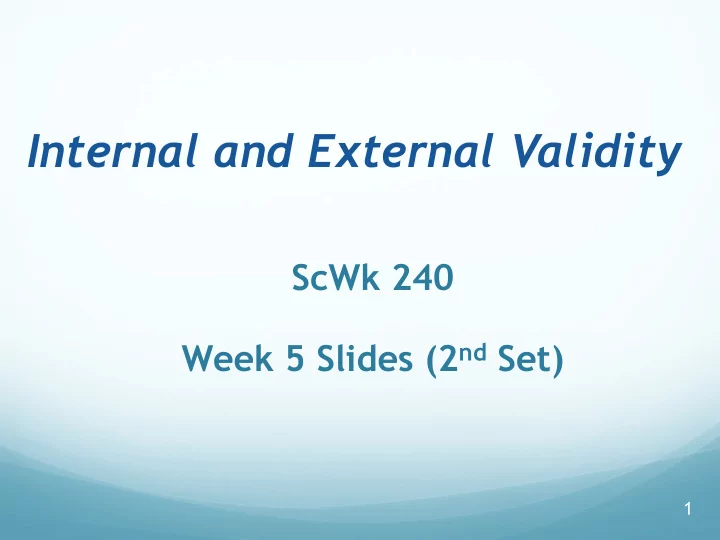

Internal and External Validity ScWk 240 Week 5 Slides (2 nd Set) 1
Defining Characteristics When research is designed to investigate cause and effect relationships (explanatory research) through the direct manipulation of an independent variable and control of extraneous variables. Review of Terms: Independent variable – the variable being manipulated Dependent variable – the variable in which the effect of the manipulation of the independent variable is observed Researcher manipulation and control – choice of treatments, choice of a research design, use of specific procedures, etc. 2
Selecting Your Research Question(s) Consider using the FINER Framework Is Your Research Question: F easible I nteresting N ovel E thical R elevant 3
Manipulation in Research Manipulation The researcher ’ s decisions related to what constitutes the independent variable Active and assigned variables Active variables are those the researcher actively manipulates Choice of an instructional strategy A particular intervention approach Assigned variables are those that cannot be manipulated by the researcher but are of interest: Gender Race 4
Control in Research Control The researcher ’ s efforts to remove the influence of any extraneous variables that might have an effect on the dependent variable The goal is to be assured the only differences between groups is that related to the independent variable Participant variables – characteristics of the subjects Pre-existing functioning levels Differences in attitudes Environmental variables – characteristics of the context Intervention materials Differences in the time available for treatment between groups 5
Reliability Implies that the same data would have been collected each time over repeated tests/ observations. Would a particular technique (or survey question) yield the same result each time? “ Did you go to your support group last week? ” vs. “ How many times have you been to these support groups in your life? ” Reliability does not ensure accuracy. Taken from Babbie, E. 6
External and Internal Validity Internal Validity – the degree to which the results are attributable to the independent variable and not some other rival explanation External Validity – the extent to which the results of a study can be generalized 7
Threats to Internal and External Validity – Questions: ■ Are the investigator’s conclusions correct? ■ Are the changes in the independent variable indeed responsible for the observed variation in the dependent variable? ■ Might the variation in the dependent variable be attributable to other causes? 8
Causal Inference Three conditions of causality: 1. Cause precedes the effect 2. Cause and effect must correlate 3. No third variable involved 9
Correlations Relationships between variables can be either: Strong or weak Positive or negative Strongest (perfect) positive correlation is +1 Strongest (perfect) negative correlation is -1 No correlation (unrelated variables) is 0 A weak positive relationship is 0.2 A weak negative relationship is -0.2 10
Internal Validity Internal Validity § Confidence that changes in Dependent (DV) Variable are actually caused by the Independent Variable (IV) v Validity (in measurement) 11
Why is Internal Validity Important? ■ We often conduct research in order to determine cause-and-effect relationships. ■ Can we conclude that changes in the independent variable caused the observed changes in the dependent variable? ■ Is the evidence for such a conclusion good or poor? ■ If a study shows a high degree of internal validity then we can conclude we have strong evidence of causality. ■ If a study has low internal validity, then we must conclude we have little or no evidence of causality 12
Internal Validity (Cont.) Eight Threats to Internal Validity: § Factors other than IV affects DV: 1. History 2. Maturation (passage of time) 3. Testing 4. Instrumentation 13
Internal Validity (Cont.) Eight Threats to Internal Validity (Cont.): 5. Statistical regression 6. Research reactivity 7. Selection biases 8. Attrition (experimental mortality) 14
External Validity § Generalizability § Representativeness of sample, setting and procedures § Sampling and survey research 15
Threats to External Validity Pre-test treatment interaction Multiple treatment interference Selection treatment interaction Specificity of variables Participants Operational definition of the treatment Operational definition of the dependent variable Specific times Specific circumstances Treatment diffusion and inconsistencies 16
Recommend
More recommend